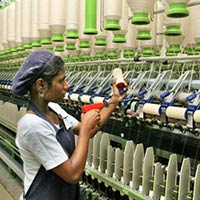 Representatives of the Confederation of Indian Textile Industry, South India Millers’ Association, North Indian Millers Association, and Texprocil met in New Delhi on Monday to take stock of the situation faced by cotton spinning mills. Currently, the cotton spinning mills are facing crisis due to high input costs and subdued demand and thus decided to go slow on production.
Representatives of the Confederation of Indian Textile Industry, South India Millers’ Association, North Indian Millers Association, and Texprocil met in New Delhi on Monday to take stock of the situation faced by cotton spinning mills. Currently, the cotton spinning mills are facing crisis due to high input costs and subdued demand and thus decided to go slow on production.
In the meeting, it was decided to appoint an agency to study the gravity of the situation, prepare a memorandum, and send to the government.
Most of the mills have either already cut production by 15 to 20 per cent or are mulling to do so soon. Salem-based Sambandam Spinning Mills is one such. Its director S Dinakaran said that the mill is keeping operations suspended for one day every week, starting this month. This is the first time in 40 years that the mill has faced such a crisis that production has had to be scaled down.
While bigger players are resorting to a one-day production cut, smaller ones have opted to shut production for two days a week. The plight of cotton mills in north India, too, is similar.
What has added to the woes of the sector is the dramatic increase in capacity over the past few years on the back of incentives offered by various state governments. This, as well as a drastic fall in export demand, has put the sector in a shambles.
According to D K Nair, secretary-general, Confederation of Indian Textile Industry, the sharp decline in exports from a peak of 140 million kg a month last year to an average of 100 million a month in this quarter has put the spinning sector in doldrums. A 40 per cent decline in export demand in such a short span was unexpected and the sector was not prepared for this. The devaluation of yuan might further hamper exports as Indian yarn has become more expensive in the international market in the after effects of Chinese currency’s fall.
President of South Indian Spinners’ Association, C Varadarajan said that as the textile sector is one of the largest employers, production cuts for a longer time could result in layoffs, resulting in labour unrest. The situation is precarious and the government should provide immediate relief to save the livelihood of millions engaged in textile sector.
There is also a need to revive the interest subvention, for release of pending TUF, and introduction of measures to expedite exports.














